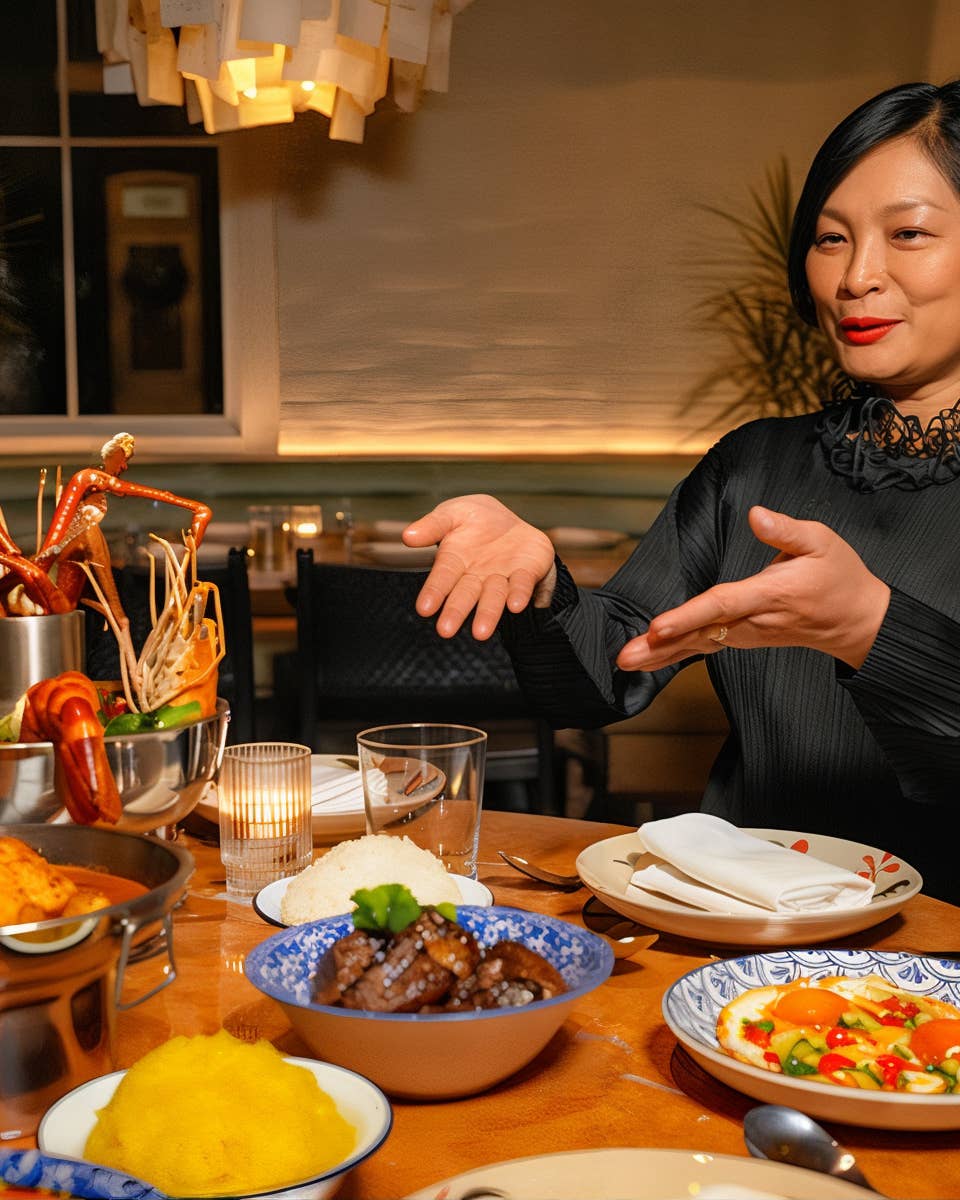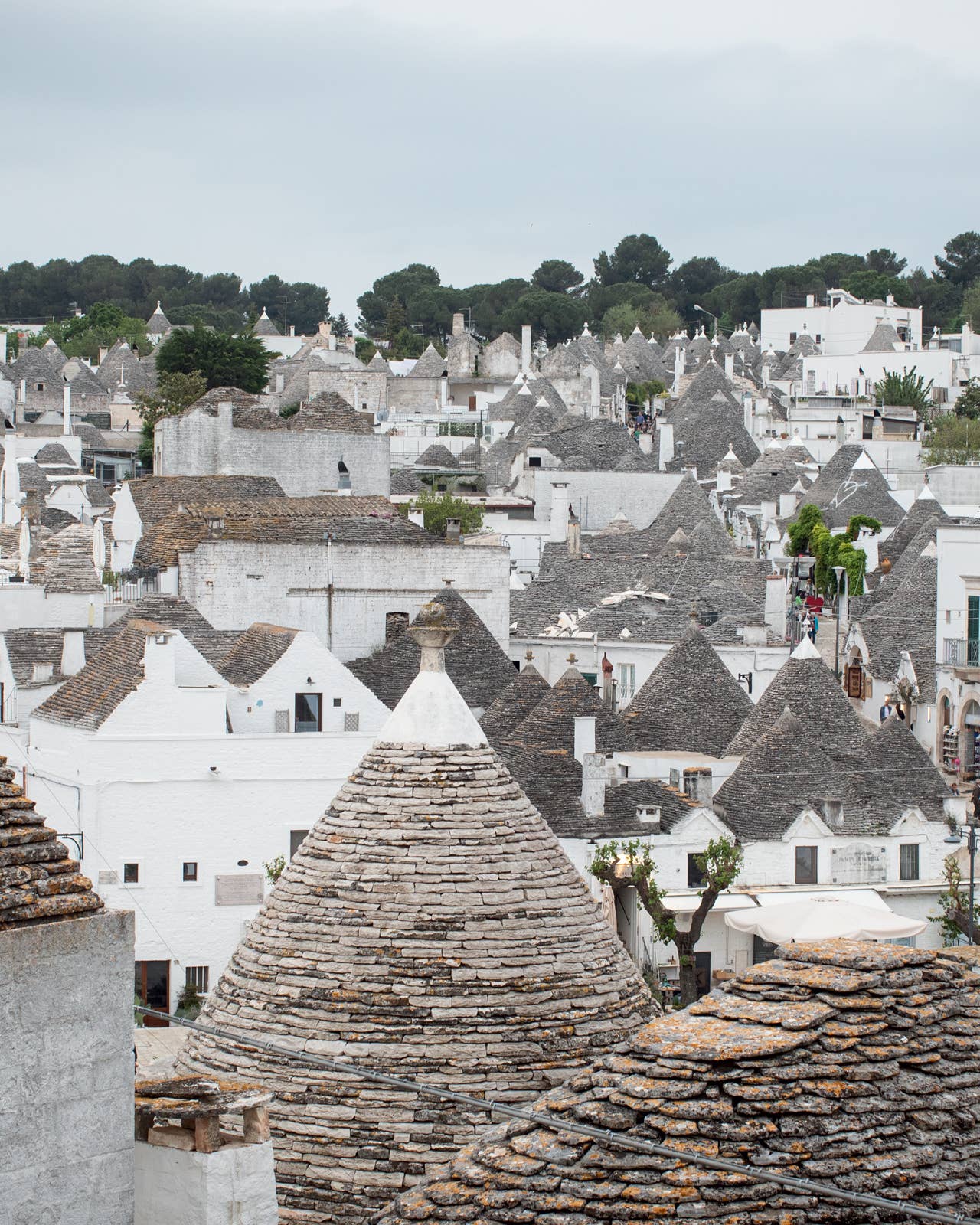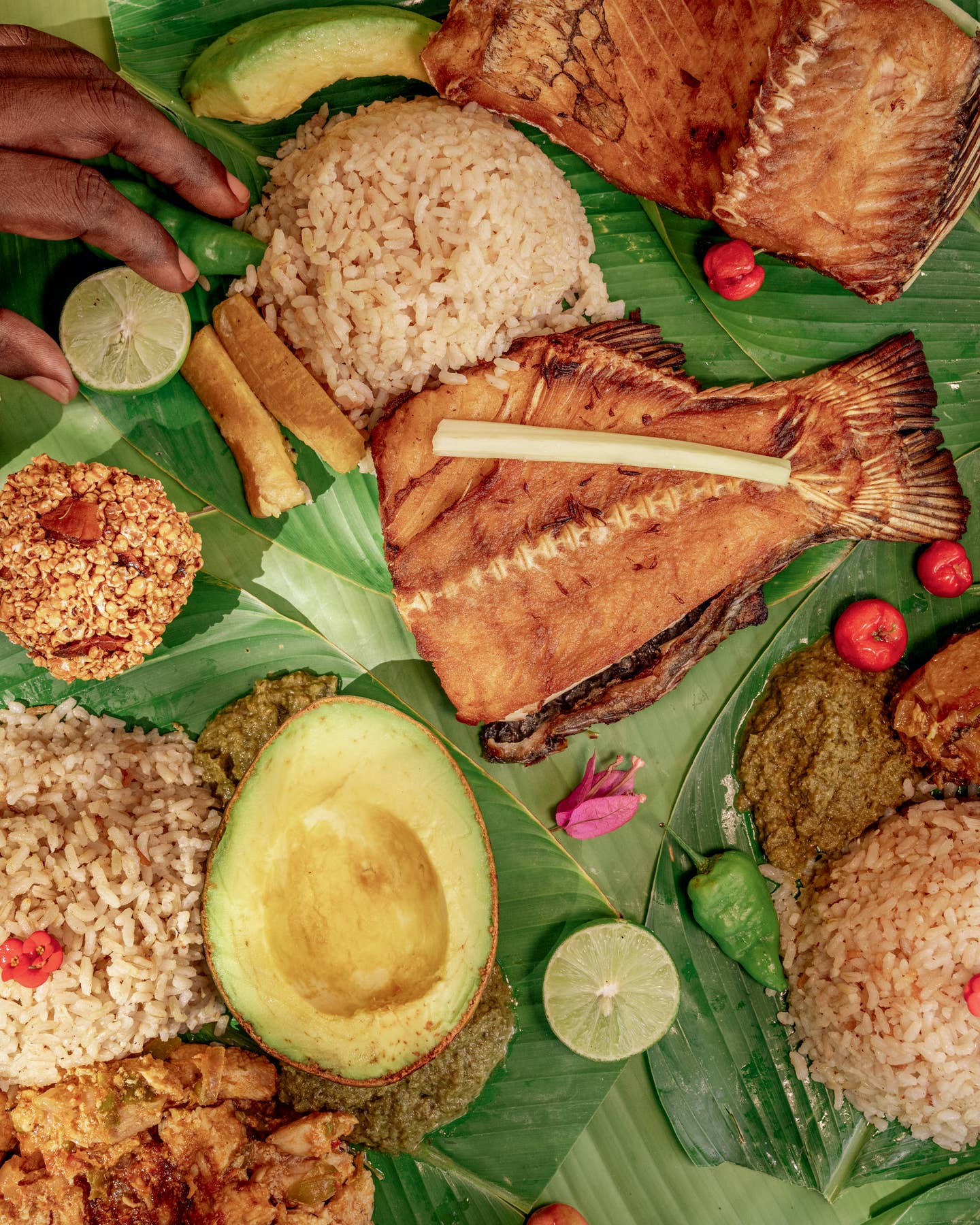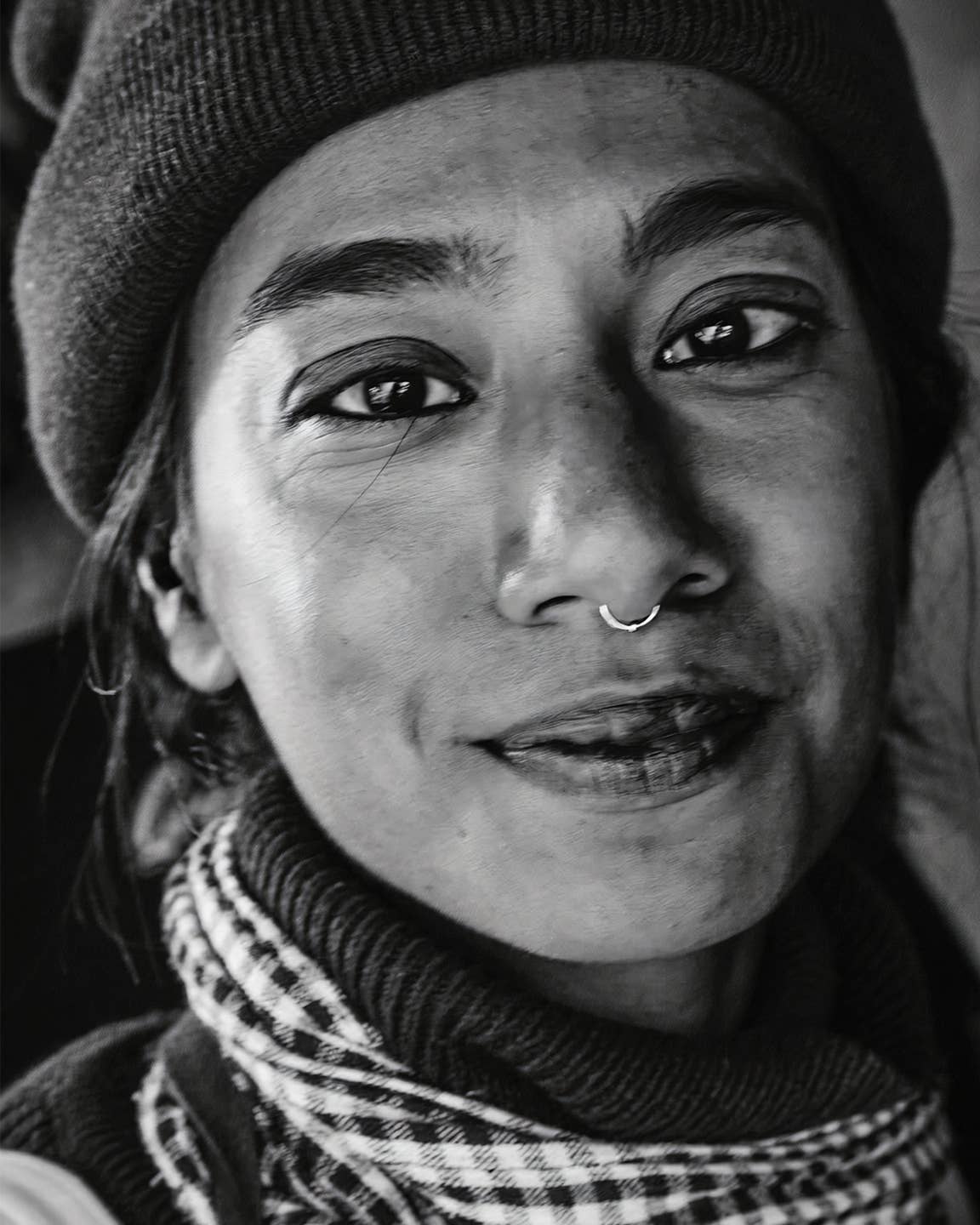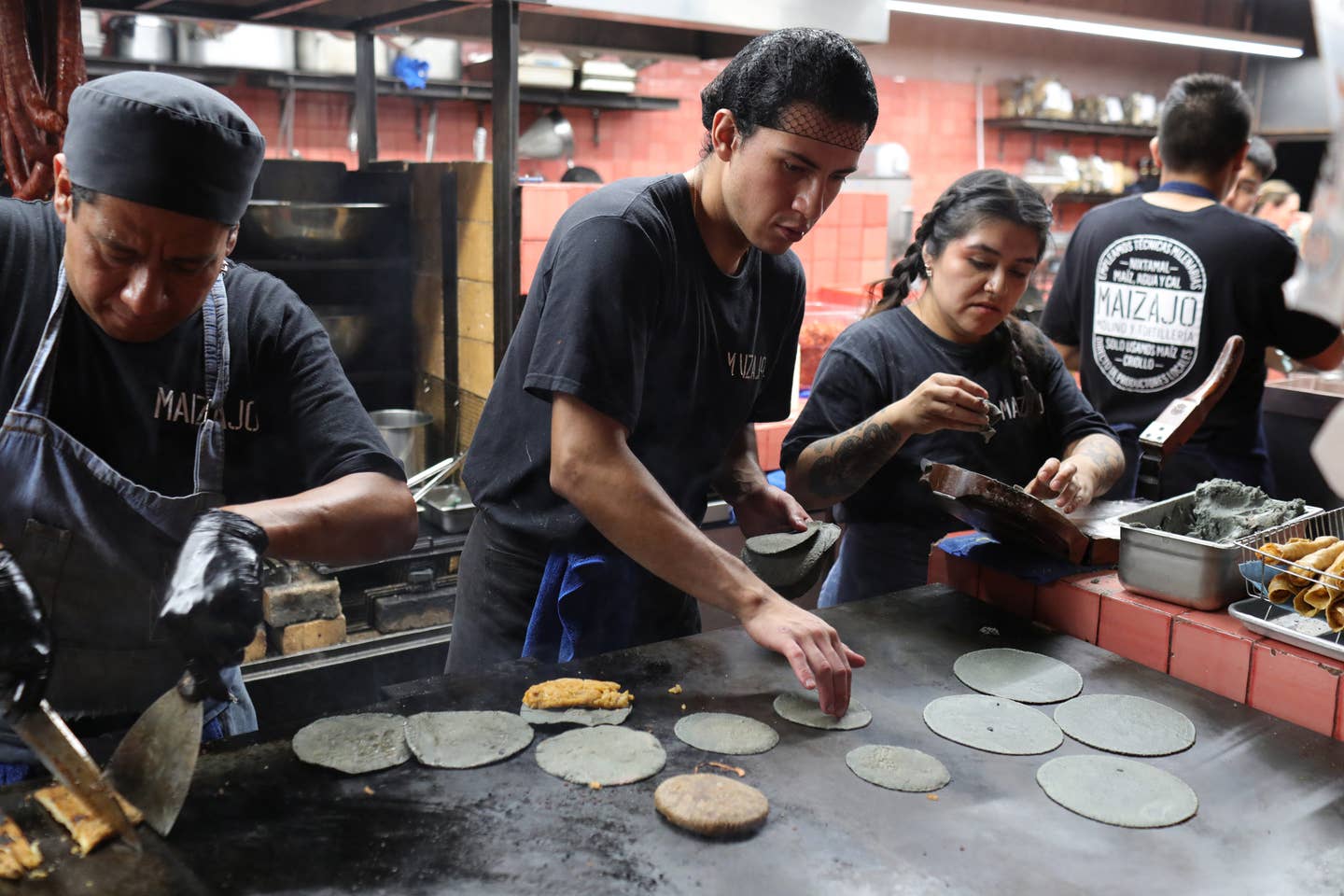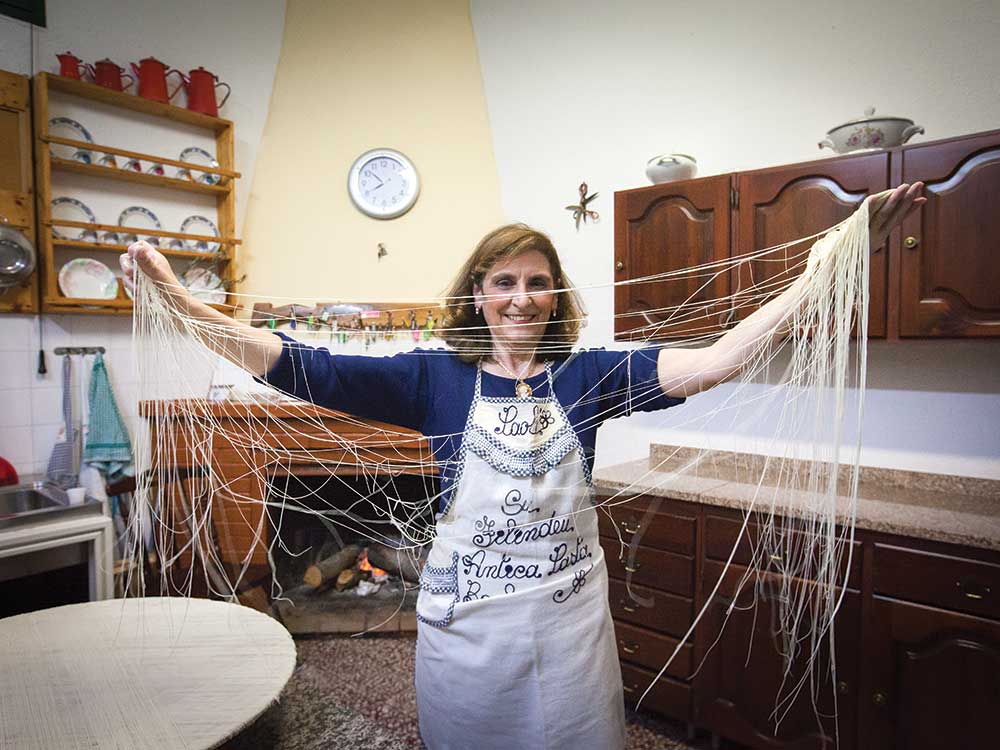
On the Hunt for the World’s Rarest Pasta
Delicate and impossible to replicate, su filindeu (or the “threads of God”) is a pasta made of hundreds of tiny strands by a single woman in a hillside town in Sardinia. She’ll make it for you too—if you’re willing to walk 20 miles overnight
A bitter wind ripped along the valley floor, through wild olive trees and up the crumbly hillside where everything was sucking. My interpreter, Mavi, and I were shivering and walking with no end in sight. Then again, nothing was in sight—it was the middle of a dark night in the middle of a remote island in the middle of the Mediterranean. I swung my headlamp toward Mavi and observed a troubling paleness to her face. What were we doing? “You can eat my body if I don’t make it,” I said. She noted that we’d only been walking for 25 minutes. We were not alone. Ahead of us and behind us were 200 fellow hikers, who alarmingly appeared more or less fine. Hikers doesn’t really capture their commitment though. These were pilgrims. I’d come to join their annual holy slog from the small city of Nuoro to the tiny village of Lula. From its promontory above a valley buzzing with scrub and juniper and oleander, the Santuario di San Francesco attracts hundreds of Sardinia’s devout each spring. They trudge 20 miles in the dark to receive grace within the sanctuary’s whitewashed walls.
Because at the end of their pilgrimage, the weary are rewarded with two things: a footbath and a bowl of steaming noodles. The footbath is just a footbath, but the noodles are extraordinary. Su filindeu is—quasi-official designation here—the rarest pasta on the planet. The dish is made specifically for this occasion; its very existence revolves around this trek. So specialized and obscure and mind-bendingly intricate is it that only a few souls can make it. And only those who reach Lula will ever try it.
The journey began on Nuoro’s dark, narrow streets. Mavi and I walked and walked and then suddenly there they were, a crowd of pilgrims milling about outside an old church. I don’t know what I was expecting—gauzy robes? shroudy headwear?—but with their frame packs and walking poles they looked like extras from an L.L. Bean catalogue. At midnight we entered the church, sat through a breathtakingly thorough Mass, then spilled back out to the street to begin.
Out of the town center we shuffled, past a darkened gas station, along an old wall, into the countryside. Asphalt became dirt road; dirt road became dirt path. We slogged past looming boulders and gnarled cacti under a useless sliver of moon. To most travelers, Sardinia is a paradise of white sand beaches and dappled grottoes. But the interior is another story. The Romans could never conquer these parts, so forbidding and savage were they. It became bandit country, and according to legend a bandit was responsible for this very pilgrimage. Acquitted of a murder charge long ago, this fellow supposedly wandered the hills and eventually built the Santuario di San Francesco in a show of gratitude for his exoneration. It’s his steps we were retracing now.
Back in California I scoff at the rubes who wait an hour outside the latest trendy restaurant. Now I was hiking all night for a bowl of carbs. A remarkable one, to be fair. Take a fine-tipped pen, do some crosshatching, then do some more. That's what su filindeu looks like in its finished state—a gauzelike lattice of insanely thin noodles. The trick of turning three common ingredients—durum wheat semolina, water, and salt—into, as the name translates, "the threads of God," takes decades to master. In 2016 Jamie Oliver came, tried, and failed. Ditto Barilla. Barilla the pasta-making company.
It was nearly half a century ago that a woman named Paola Abraini learned the technique from her mother-in-law, who had learned it from a previous generation of mothers. Now, in the run-up to the pilgrimage, Abraini prepares hundreds of pounds of the stuff. It starts with an ordinary dough, which she kneads and moistens until a soft, deeply elastic consistency forms. When does she sprinkle in more water? When she feels it in her bones, they say. A similar instinct guides her hands as they pull the dough into increasingly thin strands without ever breaking them.
Once thin enough, a layer of the strands is laid across a round wooden tray. A second layer is then added at a different angle, then another at a third angle. The tray is dried under the sun. Once firm, it’s ready to be crumbled into a vat of boiling sheep broth on the big day. Lest anyone miss out on that dank sheep flavor, a heap of local sheep’s milk cheese is thrown into the mix.
The Sardinian writer Grazia Deledda alluded to su filindeu in her 1903 novel Elias Portolu, whose protagonist feasts on it upon completing the pilgrimage. Deledda won the Nobel Prize for Literature in 1926. It was Elias Portolu's glancing account of the schlep to Lula that struck me. Deledda acknowledged "the wild nocturnal solitude of the scrubland" and that "the climb was hard and dry." But in real life we'd long since passed hard and dry, and the trek had gone from amusingly brisk to plain old grueling.
As we hiked, Mavi and I discussed the pasta, how long until we could eat it, whether anyone had ever died on this walk, and whether anyone would find us if we did. At one point, attempting to pinpoint our exact discomfort, we realized it was total; everything hurt. This was liberating, somehow. It couldn’t get worse. And that’s how we were feeling when it came: the devastating sight of two dozen flashlights up ahead, searching left then right. We watched with dawning comprehension as the beams turned around and began heading back our way. The group was lost. I’d always thought of pilgrims as a directed species, possessing some kind of holy GPS. But they’re just people. Our trail had just barely been a trail to begin with; it wasn’t on the internet; our phones didn’t work anyway; we had no leader. Italians have both their italics and bold switched on when they speak, but the crew became oddly quiet, heads down, retracing steps. Narrow winding path. Ancient stone walls. Scrub spilling down a rocky cliff. The smell of an unseen horse on a cold wind. The desperate sweep of flashlight beams over a vast, inky valley. A strange loopiness descended. Beside a thicket Mavi mentioned the possibility of poisonous snakes. “Rattlesnakes?” I asked. “What is rattlesnakes?” I made a rattlesnake noise with my mouth. She didn’t like that. Above a steep shale ravine, the guy in front of me wobbled. I moved to catch him, but he recovered. “Allora,” he mumbled, with a tiredness like it almost didn’t matter. At 4 A.M., my thoughts drifted to the pasta that felt so out of reach. Historically the su filindeu process was something of a family secret. Abraini’s acquaintances told me she’s leery of the tradition getting diluted—commercialized, tourism-ized, whatever robs a ritual of its specialness. But surely, goes the counterargument, dying out would be worse. If the pasta baton isn’t passed, one day it’ll quietly join the growing list of extinct foods.
Slow Food's Ark of Taste is the list that warns us about that list. Since its launch in 1996, the project has catalogued some 4,000 dishes and ingredients in jeopardy: brown beans from Sweden's Öland island, Mirandaise cattle from Gascony, the Umqombothi beer of South Africa's Xhosa people—and su filindeu. As the journalist Simran Sethi has written, three-quarters of the world's food comes from just 12 plants and five animal species. What we don't eat vanishes; humans will never again taste an Ansault pear, no matter how much they want to. "Eat it to save it," the Ark of Taste dictum goes. Very different from how we save, say, mountain gorillas.
As I walked, I couldn't help noticing a certain irony. This rare unicorn of a pasta had transformed into something sadly common: another thing to worry about. Between the giant panda and, I don't know, authentic Hawaiian slide guitar, my reserves of concern for Endangered Good Things have been stretched as thin as su filindeu itself. Looking at the towering mass of problems, it's hard to fret over something as theoretical as a pasta you've never tasted, made on a hilltop you've never heard of.
But then you connect this random noodle to an actual human tradition, born of actual humans like you see at the DMV or your niece's birthday party or, hell, in your own home, and suddenly it's not theoretical at all. I thought about the smoothies I made my kids when they were younger. A ridiculous comparison, of course, but in our absurd way we'd carved out a food tradition of our own. As with su filindeu, the threat of extinction always hovered. Nobody made smoothies quite the way I did. And when my children pivoted to Cheerios one day, that was that. Within the very small culture of my house, a little culinary ritual ceased to exist.
All at once I didn't just care about the fate of su filindeu, I now possessed the key for caring about any crisis that might otherwise slip into abstraction: You can't think about how significant it is. You must think about how insignificant it is—that is, born of a million tiny personal moments. Add them up and that's how you get that non-tiny word, culture. How many lives had su filindeu intersected over the years? How many memories had it woven itself through—all to vanish one day, along with a singular connection to this remote corner of earth? I could have kept going in that vein for several more miles. Then Mavi smacked my shoulder. Smoke was rising ahead, the unmistakable wisps of a mid-pilgrimage bonfire. The hikers in front of us had found their way.
Sitting by those flames was an achy sort of heaven I won’t forget. Saintly locals passed around paper cups of an eggy, homemade liqueur called vov. I heard two men dissect the different preparations of a pasta in their respective villages. Across the fire I watched a raspy-voiced woman break out in laughter with her niece. She was missing some key teeth. She wheezed, delighted.
For my fellow walkers, pasta was merely an earthly bonus for their pious exertions. I met a man in his 70s, so devout he'd hiked the 100-plus miles from Cagliari to Nuoro, a pilgrimage to this pilgrimage. This was his 35th journey to the sanctuary. I asked what he thinks about while walking. I sing, he said, as though there could be no other reply. I suddenly realized I loved this pilgrimage.
We sat a good while. Some young people sang—pop songs, childhood songs, ballad-y songs that confirmed my suspicions that Italians simply feel more. Before we got back on the trail, Mavi and I met a middle-aged pilgrim who'd been doing the walk since childhood. "What's changed?" I asked. I assumed he'd say it used to be better, or the young people don't appreciate it as much, maybe something about smartphones. "Niente," he said. Nothing.
Our feet were washed in buckets. Another Mass was delivered. Eight hours after setting out, we’d dragged ourselves to a large, white sanctuary. Inside a cramped little room adjoining a cramped church kitchen, we lined up to receive steaming bowls of a nearly extinct pasta. The mood was a bizarre combination of euphoric and catatonic. Our bodies bordered on numb, but it felt ecstatic to stand in that funny room, with its half-hearted décor. I stared vaguely at an ancient electrical panel until I got my su filindeu. It all happened too fast. With a plastic fork I speared what felt like a celebrity after all this time. I’ve never seen actual God’s threads, but the noodles were bafflingly fine. I can’t say they tasted like another species of pasta altogether. I mean, they tasted like pasta. The sheep broth tasted like a particularly potent and pasture-y broth. The sheep’s cheese tasted like a delicate, oozing feta. But together, and after everything, it was miles from anything I’d ever eaten. The actual celebrity responsible for the bowl in my hand was elsewhere, Mavi and I learned. We wandered into the small church kitchen and found not Paola Abraini but her cousin, fussing over another pot of broth. Abraini, it seemed, had decided to skip the big day. Maybe the su filindeu limelight had grown too bright, maybe she had stuff to do. For a good five minutes I regretted not meeting her, until I realized she was even more special in legend form. Is su filindeu going away? I don’t know. Talking to Abraini’s cousin, it was hard to gauge the sturdiness of the chain of succession. There’s concern that the younger generation isn’t totally interested. But there are also rumors that Abraini will teach classes. And then there’s the Ark of Taste, reminding the world not to blink. What felt more pressing, frankly, was the thought of the pilgrimage itself going away one day. We need these rituals. Humans doing beautiful, irrational, gentle things, like hiking 20 miles in the dark in order to receive grace on a promontory overlooking a broad valley, and a woman cooking a strange, impossible dish to honor it all. Lost in these thoughts, I didn’t fully notice who tucked the dried square of su filindeu into my hand that morning. Later the fact of it would sink in. I would wrap it in tissue paper and smuggle it out of Lula, out of Italy, back home to California where it now sits, in a drawer in my kitchen. I don’t know what to do with it, except look at it now and then, and, by God, never let it disappear.
Keep Reading
Continue to Next Story




